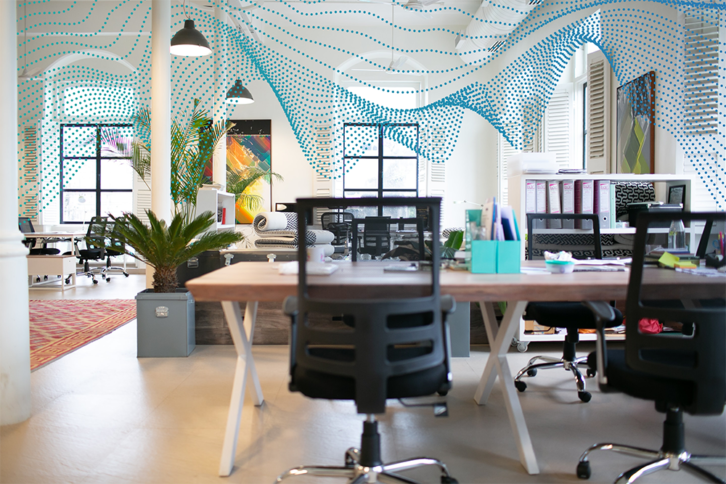A new company claims that its soundscapes increase relaxation, focus and improve creative thinking in the workplace.
Following two years of development and incubation, Moodsonic, creator of nature-inspired ‘biophilic’ soundscapes, has launched to specifically address the need to provide healthier work, healthcare, and educational spaces.
 According to Moodsonic, people spend around 90% of their time working indoors, but once inside research shows that noise is the number one complaint and the most distracting problem in the workplace, affecting our ability to concentrate, be productive, creative, and generally feel healthy and well.
According to Moodsonic, people spend around 90% of their time working indoors, but once inside research shows that noise is the number one complaint and the most distracting problem in the workplace, affecting our ability to concentrate, be productive, creative, and generally feel healthy and well.
“We created Moodsonic to address a pervasive and unaddressed need: whether in offices, hospitals, schools, or elsewhere, everyone hates the sound indoors,” said Evan Benway, founder, and managing director of Moodsonic. “All of the historical approaches have been negative; reduce the volume here, eliminate sound there. With Moodsonic we took a step back and dug deep into the science of how sound affects us, psychoacoustics, and acoustic engineering, to build technology to optimise the soundscape indoors.
“Founded on a deep respect for and understanding of our innate preferences for nature – also known as biophilia – Moodsonic channels that science into dynamic, intelligent soundscapes that make our buildings healthier, more functional, and more inviting. Buildings where the soundscape is in tune without our bodies throughout the day, where you can walk into a space and intuitively understand its purpose.”
Nature’s calming sounds have been shown to decrease muscle tension and heart-rate, help people to feel safe and secure and cue the body’s circadian rhythms, according to Moodsonic’s press announcement, which goes on to say that research by sensory experts Kinda Studios and researchers from Goldsmiths, University of London, shows that natural soundscapes can reduce the distracting power of speech and promote optimal cognitive functioning, “even better than silence”.
Highlights of recent research conducted for Moodsonic by sensory experts Kinda Studios and Goldsmiths, University of London, in a London workplace, highlighted the benefits of Moodsonic’s soundscapes compared to normal office sound:
- Compared to normal offices, Moodsonic’s soundscapes increased relaxation, as seen in both heart-rate and EEG (brainwave) measurements, the effects of which were seen to continue increasing over time.
- People could focus better with Moodsonic. They completed cognitive tests significantly quicker, without losing accuracy.
- Moodsonic’s biophilic soundscapes improved creative thinking by 12% compared to typical office sound.
“We’ve been living with a global epidemic of stress, and this research proves what we have always believed; that it’s possible to bring the sounds of nature indoors in ways that help the body and the mind to relax,” said Benway. “Beyond that, the improvements shown in focus and creativity translate to a demonstrable return on investment for companies investing in more productive workplaces.”
Comprised of software engineers and sound designers, and with the world’s largest footprint in biophilic soundscaping, Moodsonic works with architects, designers, real estate, AV, and IT to introduce biophilic soundscapes in workplaces, schools, hospitals and more. Moodsonic’s technology is said to allow for scalability, whether for soundscaping a single floor or a multistorey building, and allows for granular zoning, multichannel audio, and user control.
 Moodsonic can be implemented in conjunction with conventional speaker technology, or incorporated into more innovative designs using spatial or smart technology – translating into spaces that accommodate different activities, users with diverse sensory needs, and changing occupancy levels. The soundscapes provide users with a library of themes designed for different activities and space types and drawn from natural environments from around the world. They can even be designed around the body’s circadian rhythms. Sensors enable Moodsonic’s generative and learning software to adapt soundscape output to real-time environmental changes and to personalise the experience to local surroundings, as well as to provide long-term insight into the changing sonic environment.
Moodsonic can be implemented in conjunction with conventional speaker technology, or incorporated into more innovative designs using spatial or smart technology – translating into spaces that accommodate different activities, users with diverse sensory needs, and changing occupancy levels. The soundscapes provide users with a library of themes designed for different activities and space types and drawn from natural environments from around the world. They can even be designed around the body’s circadian rhythms. Sensors enable Moodsonic’s generative and learning software to adapt soundscape output to real-time environmental changes and to personalise the experience to local surroundings, as well as to provide long-term insight into the changing sonic environment.
During its development period, Moodsonic worked with Steelcase, a $2.8 billion global, industry leading workplace design and manufacture company, to test soundscapes at the company’s headquarters in Michigan.
“Steelcase has partnered with Moodsonic to install soundscapes on our Grand Rapids campus in specific typology of space designed for focus work,” said Gale Moutrey, VP of workplace innovation & brand management at Steelcase. “By introducing the soundscapes from Moodsonic, the space has become one the most utilised on campus. The biophilic sounds give people a sense of mental and psychological well-being they are not able to find in other spaces,”
Moutrey goes on to say that the Moodsonic area is “always in use. It’s reservable and very challenging to secure. Users love the ability to select a soundscape that fits their individual mood and need and for heads down work, it’s great to be able to listen to the sounds of nature to help achieve focus. It’s a world of difference from the white noise users hear in other areas of the campus.”
Benway concluded: “Our vision with Moodsonic is to turn sound from a painful afterthought into a positive and exciting design tool. We want to show that without breaking the bank, organisations of all sizes can create spaces where all the senses work together in harmony. Spaces that are less stressful and more engaging, and where people feel calm, secure, and productive. Inclusive spaces for everyone, where no matter our degree of sensory sensitivity, we can find options that nurture and support us. Moodsonic is leading the way in designing soundscapes based on science, and buildings that use sound to connect us back to nature.”







